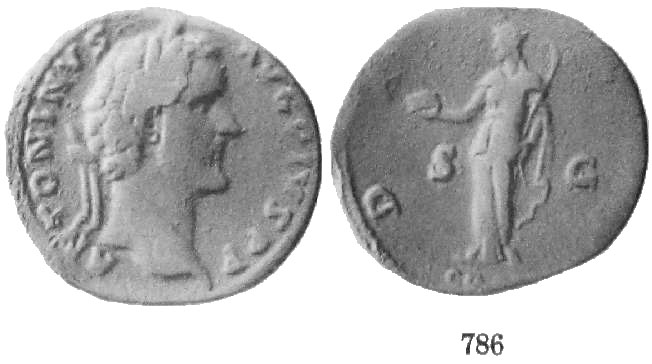| BrianRxm | Coin Stories | 15/16 |
| Roman Antoninus Pius Sestertius Dacia |
An unusual Roman coin not in standard Roman coin catalogs
| Prev | Back | Next |
Ebay purchase of Roman Sestertius turns into a long identification process.
The Coin:

1. Antoninus Pius Sestertius Dacia
Bronze, 31 mm, 23.58 gm
Obverse: Laureate head right, ANTONINVS AVG PIUS
Reverse: Dacia standing, holding curved sword, D in lower left, S C in field
Reverse: Dacia standing, holding curved sword, D in lower left, S C in field
The Story:
I bought this coin on Ebay in April 2007.
The seller only described it as a "Antoninus Pius Sestertius."
Antoninus Pius was the emperor of Rome from AD 138 to AD 161.
There is a large letter 'D' to the left and below the 'S' of 'SC', and I could not figure out what that meant.
I could not identify the coin using internet data bases like Wildwinds, and put it away.
I was able to borrow a copy of the 1930 edition of RIC Volume 3 and found a similar coin in one of the plates,
a "DACIA" Sestertius, RIC 581.
("RIC" is "The Roman Imperial Coinage", written and edited by Mattingly, Harold, Sydenham, and others,
a 10-volume catalog of Roman coins originally published in the 1920's and revised since then)
As far as I could tell, my coin was RIC 581, I posted it on a coin identification board,
and asked for verification.
A poster at another board replied that it looked like a Dacia variant with a different reverse,
Dacia holding a curved sword, and that the variant was not in RIC or Cohen but was in "Strack",
possibly struck from the same dies.
("Cohen" is "Description Historique des Monnaies Frappees sous L'Empire Romain",
by Henry Cohen, an 8-volume catalog of Roman coins published in the 1880's and still used)
I did not know who "Strack" was, but I do now.
Paul L. Strack was a German history professor and numismatist who wrote three catalogs of Roman coins
in the 1930's for the coins of the emperors Trajan, Hadrian, and Antoninus Pius.
The University of California (Berkeley) library had all three of Stracks books.
The ones for Trajan and Hadrian were checked out but not one for Antoninus Pius.
The library offered to let me look at the book at their library annex in Richmond.
Paul L. Strack:
Paul L. Strack (1904-1941) was born in Giessen, Germany on October 2, 1904.
His father Max Strack was a professor of ancient history and Paul Strack also became a professor
specializing in the Roman Empire.
Strack began his multi-volume main work "Studies on the Roman Empire in the Second Century"
which cataloged coins in various collections.
Some of Strack's work appeared in Harold Mattingly's Roman Imperial Coinage.
Paul Strack joined the Sturmabteilung or "SA", a Nazi organization in 1933.
In 1941 Strack joined the staff of the "Reich University" in Strasbourg, which was operated
by another Nazi organization, the Schutzstaffel or "SS."
A division of the Ahnenerbe or "ancestral heritage", another Nazi historical organzation,
was located at the university and Strack may have been a member of that group.
In 1941, believing that he was not doing enough for Germany, Strack joined the Army.
He became an officer and was sent to the Russian front where he was killed on August 3, 1941.
The Catalog:

2. Strack Plate IX Number 786
Strack stated that examples were in the Vatican and Leningrad Hermitage collections in the 1930's.
From RIC, Volume 3:
This coin was part of a set issued in AD 139 depicting Roman provinces offering presents to the
new emperor. The provinces are represented offering crowns of various shapes.
Antoninus gave half of the presents back to the provinces.
| Prev | Back | Next |